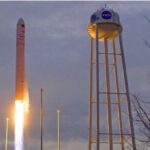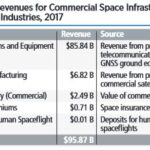Browse Resources by Year
Space infrastructure, like its terrestrial counterpart, is an invisible backbone for services used by people all over the world. Like terrestrial infrastructure, space infrastructure is increasingly relied upon for convenience, services, and national security/defense. If there was an emerging trend during 2017, it is that space infrastructure is . . .
Read MoreWhether suborbital or orbital, the world remained busy launching vehicles into space. The distinction between suborbital and orbital launch is very specific. Suborbital launches lack…
Read MoreThe Commercial Space Products and Services section captures the sale of products and services enabled by space asset . . .
Read MoreIn 2017, commercial infrastructure and support industries generated $95.87 billion in revenue, 7.5% more than 2016. This category focuses on hardware and services provided by the private sector to enable the development, launch, and successful operation of commercial space assets. It includes . . .
Read MoreGlobal government spending increased in 2017, totaling $76.2 billion, up from $72.7 billion in 2016. Government spending accounted for 19.9% of the global space economy . . .
Read MoreIf a company creates a significant product or service for those needs, the Space Foundation provides opportunities for recognition. The Space Foundation’s Space Technology Hall of Fame® inducts two deserving space technologies annually. Working with panels of space technology experts and agencies, the Space Foundation identifies and promotes the…
Read MoreWhile the International Space Station remained the cornerstone for human activities in space during 2017, companies such as…
Read MoreDuring 2017, Russia was the only nation that launched humans into orbit. Russia continued providing its service, ferrying passengers to the International Space Station (ISS). Of the…
Read MoreMost nations do not publicly release annual data about the size of their space workforce. However, some do provide information periodically, particularly with regard…
Read MoreThe Japanese space workforce grew by 325 jobs from 2015 to 2016, an increase of 3.8%. The workforce is up 73.1% since a low point in 2008, reaching its highest point since . . .
Read More

